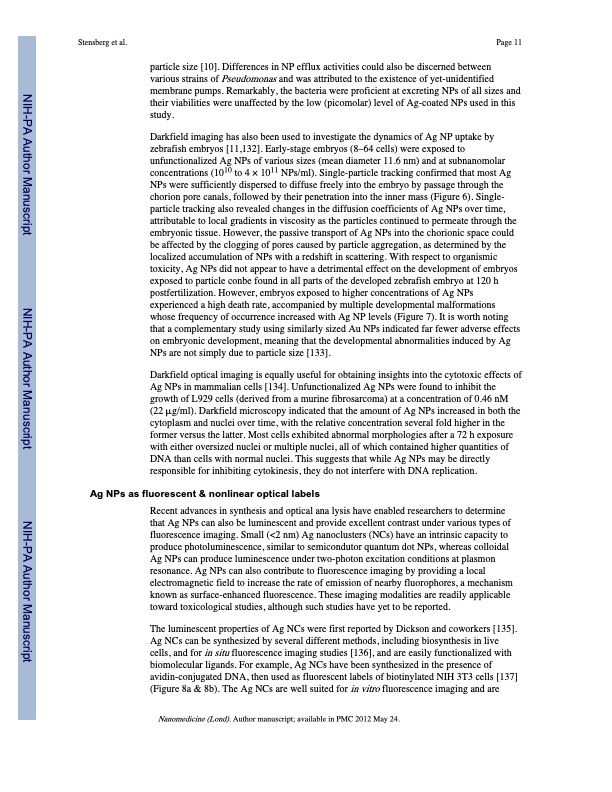
PDF Publication Title:
Text from PDF Page: 011
Stensberg et al. Page 11 particle size [10]. Differences in NP efflux activities could also be discerned between various strains of Pseudomonas and was attributed to the existence of yet-unidentified membrane pumps. Remarkably, the bacteria were proficient at excreting NPs of all sizes and their viabilities were unaffected by the low (picomolar) level of Ag-coated NPs used in this study. Darkfield imaging has also been used to investigate the dynamics of Ag NP uptake by zebrafish embryos [11,132]. Early-stage embryos (8–64 cells) were exposed to unfunctionalized Ag NPs of various sizes (mean diameter 11.6 nm) and at subnanomolar concentrations (1010 to 4 × 1011 NPs/ml). Single-particle tracking confirmed that most Ag NPs were sufficiently dispersed to diffuse freely into the embryo by passage through the chorion pore canals, followed by their penetration into the inner mass (Figure 6). Single- particle tracking also revealed changes in the diffusion coefficients of Ag NPs over time, attributable to local gradients in viscosity as the particles continued to permeate through the embryonic tissue. However, the passive transport of Ag NPs into the chorionic space could be affected by the clogging of pores caused by particle aggregation, as determined by the localized accumulation of NPs with a redshift in scattering. With respect to organismic toxicity, Ag NPs did not appear to have a detrimental effect on the development of embryos exposed to particle conbe found in all parts of the developed zebrafish embryo at 120 h postfertilization. However, embryos exposed to higher concentrations of Ag NPs experienced a high death rate, accompanied by multiple developmental malformations whose frequency of occurrence increased with Ag NP levels (Figure 7). It is worth noting that a complementary study using similarly sized Au NPs indicated far fewer adverse effects on embryonic development, meaning that the developmental abnormalities induced by Ag NPs are not simply due to particle size [133]. Darkfield optical imaging is equally useful for obtaining insights into the cytotoxic effects of Ag NPs in mammalian cells [134]. Unfunctionalized Ag NPs were found to inhibit the growth of L929 cells (derived from a murine fibrosarcoma) at a concentration of 0.46 nM (22 μg/ml). Darkfield microscopy indicated that the amount of Ag NPs increased in both the cytoplasm and nuclei over time, with the relative concentration several fold higher in the former versus the latter. Most cells exhibited abnormal morphologies after a 72 h exposure with either oversized nuclei or multiple nuclei, all of which contained higher quantities of DNA than cells with normal nuclei. This suggests that while Ag NPs may be directly responsible for inhibiting cytokinesis, they do not interfere with DNA replication. Ag NPs as fluorescent & nonlinear optical labels Recent advances in synthesis and optical ana lysis have enabled researchers to determine that Ag NPs can also be luminescent and provide excellent contrast under various types of fluorescence imaging. Small (<2 nm) Ag nanoclusters (NCs) have an intrinsic capacity to produce photoluminescence, similar to semicondutor quantum dot NPs, whereas colloidal Ag NPs can produce luminescence under two-photon excitation conditions at plasmon resonance. Ag NPs can also contribute to fluorescence imaging by providing a local electromagnetic field to increase the rate of emission of nearby fluorophores, a mechanism known as surface-enhanced fluorescence. These imaging modalities are readily applicable toward toxicological studies, although such studies have yet to be reported. The luminescent properties of Ag NCs were first reported by Dickson and coworkers [135]. Ag NCs can be synthesized by several different methods, including biosynthesis in live cells, and for in situ fluorescence imaging studies [136], and are easily functionalized with biomolecular ligands. For example, Ag NCs have been synthesized in the presence of avidin-conjugated DNA, then used as fluorescent labels of biotinylated NIH 3T3 cells [137] (Figure 8a & 8b). The Ag NCs are well suited for in vitro fluorescence imaging and are Nanomedicine (Lond). Author manuscript; available in PMC 2012 May 24. NIH-PA Author Manuscript NIH-PA Author Manuscript NIH-PA Author ManuscriptPDF Image | Toxicological studies on silver nanoparticles

PDF Search Title:
Toxicological studies on silver nanoparticlesOriginal File Name Searched:
nihms-316964.pdfDIY PDF Search: Google It | Yahoo | Bing
Turbine and System Plans CAD CAM: Special for this month, any plans are $10,000 for complete Cad/Cam blueprints. License is for one build. Try before you buy a production license. More Info
Waste Heat Power Technology: Organic Rankine Cycle uses waste heat to make electricity, shaft horsepower and cooling. More Info
All Turbine and System Products: Infinity Turbine ORD systems, turbine generator sets, build plans and more to use your waste heat from 30C to 100C. More Info
CO2 Phase Change Demonstrator: CO2 goes supercritical at 30 C. This is a experimental platform which you can use to demonstrate phase change with low heat. Includes integration area for small CO2 turbine, static generator, and more. This can also be used for a GTL Gas to Liquids experimental platform. More Info
Introducing the Infinity Turbine Products Infinity Turbine develops and builds systems for making power from waste heat. It also is working on innovative strategies for storing, making, and deploying energy. More Info
Need Strategy? Use our Consulting and analyst services Infinity Turbine LLC is pleased to announce its consulting and analyst services. We have worked in the renewable energy industry as a researcher, developing sales and markets, along with may inventions and innovations. More Info
Made in USA with Global Energy Millennial Web Engine These pages were made with the Global Energy Web PDF Engine using Filemaker (Claris) software.
Infinity Turbine Developing Spinning Disc Reactor SDR or Spinning Disc Reactors reduce processing time for liquid production of Silver Nanoparticles.
| CONTACT TEL: 608-238-6001 Email: greg@infinityturbine.com | RSS | AMP |